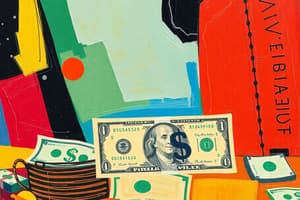Podcast
Questions and Answers
Which of the following is the MOST important function of money in an economy?
Which of the following is the MOST important function of money in an economy?
- Limiting trade to barter systems for local goods and services.
- Acting as a decorative item and symbol of wealth.
- Providing intrinsic value based on its material composition.
- Serving as a universally accepted medium of exchange. (correct)
Which of the following scenarios BEST illustrates the function of money as a 'store of value'?
Which of the following scenarios BEST illustrates the function of money as a 'store of value'?
- Using money to immediately purchase perishable goods.
- Holding money in a savings account for future use. (correct)
- Exchanging money for goods in a barter system.
- Spending all of one's income as soon as it is received.
What characteristic of commodity money differentiates it from fiat money?
What characteristic of commodity money differentiates it from fiat money?
- Commodity money is easily portable, while fiat money is not.
- Commodity money has intrinsic value based on the material it is made of, while fiat money does not. (correct)
- Commodity money is controlled by a central bank, while fiat money is not.
- Commodity money is used only for international trade, while fiat money is used domestically.
Why is standardization an important characteristic of money?
Why is standardization an important characteristic of money?
Which of the following is a KEY advantage of a fiat money system compared to a gold standard?
Which of the following is a KEY advantage of a fiat money system compared to a gold standard?
Flashcards
What is Money?
What is Money?
Anything generally accepted as a medium of exchange, a store of value, and a unit of account.
Evolution of Money
Evolution of Money
The historical progression of forms of money, from bartering to metal coins, paper money, and digital currency.
What is a Banknote?
What is a Banknote?
A physical form of currency issued by a central bank, typically made of paper or polymer.
New Generation Currency
New Generation Currency
Signup and view all the flashcards
Who is Katrina Marie M. Miranda?
Who is Katrina Marie M. Miranda?
Signup and view all the flashcards
Study Notes
- Money is commonly used and generally accepted as a medium of exchange or as a standard of value.
- Money is one of the most outstanding inventions in the history of mankind.
- Functions of money include medium of exchange, standard of value and store of value.
- Commodities have been used as mediums of exchange and standards of value throughout history.
- Monetary standards are described in terms its standard money.
- Legal tender means legal means of payments.
- A good feature of the inconvertible paper standard is the money supply.
- Money supply refers to money in circulation.
- Money supply is composed of currency circulation, demand deposit or checking account, savings and time deposits and large negotiable certificates of deposits at commercial banks.
- Monetary theory analyzes the role of money in the economic system.
- Monetary theory is simply the theory of the value of money.
- Value of money refers to its purchasing power.
- The quantity theory of money is a popular monetary theory.
Quantity Theory of Money Formula
- M is the total amount of money in the economy.
- V is the velocity of circulation of money.
- P is the general price level in the economy.
- T is the total index of physical volume of transactions.
Brief History of Philippine Money
- Trade among the early Filipinos and with traders from the neighboring islands was conducted through barter.
- The inconvenience of barter later led to the use of some objects as medium of exchange.
- Barter is where people exchanged goods directly for other goods.
- Three hundred years of Spanish rule left many indelible imprints on Philippine numismatics.
- At the end of the Spanish regime, Philippine money was a multiplicity of currencies including Mexican pesos, Alfonsino pesos and copper coins of other currencies.
- The Philippine Republic of 1898 under General Emilio Aguinaldo issued its own coins and paper currency backed by the country's natural resources.
- The Americans instituted a monetary system for the Philippine based on gold.
- The Philippine peso pegged to the American dollar at a ratio of 2:1 and the US Congress approved the Coinage Act for the Philippines in 1903.
- World War II caused disturbances in the Philippine monetary system and the Japanese Occupation Forces issued war notes in big denominations.
- The country used as currency old treasury certificates overprinted with the word "Victory" after gaining independence from the United States following the end of World War II.
Six Characteristics of Money
- Durability: Objects must withstand physical wear and tear.
- Portability: People need to be able to take money as they go about their business.
- Divisibility: To be useful, money must be easily divided into smaller denominations or units of value.
- Uniformity: Any two units of money must be uniform, the same in terms of what they will buy.
- Limited Supply: Money must be available only in limited quantities.
- Acceptability: Everyone must be able to exchange the money for goods and services.
Classification of Money
- Full bodied money's face value is equal to its intrinsic value of metal.
- The government retains a monopoly of the issue of full-bodied coins.
- Full bodied money is also called standard money
Representative full-bodied money
- Coins were supplemented with paper currency that was backed by valuable metals during the industrial revolution and the exclusive use of coins as a medium of exchange became increasingly inconvenient.
- Credit is the ability to borrow money now with the promise to repay it in the future.
- Credit can be useful but also lead to reckless spending and debt.
- "Buy now, pay later" applies to buying with credit
Electronic Banking
- The financial sector, especially in the provision of retail and wholesale financial services has been profoundly effect by the rapid development of electronic technology
- Electronic banking services are offered to personal and business customers by banks.
- The new generation currency banknote series is the current iteration of Philippine currency.
Studying That Suits You
Use AI to generate personalized quizzes and flashcards to suit your learning preferences.




